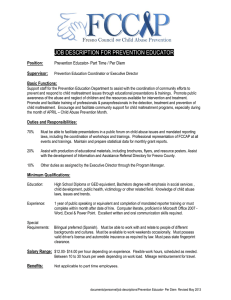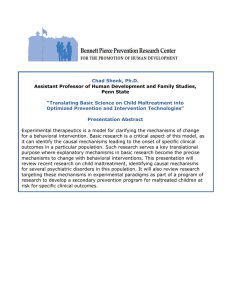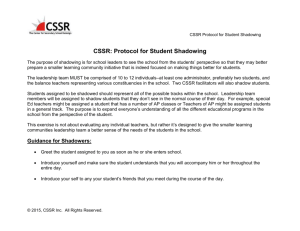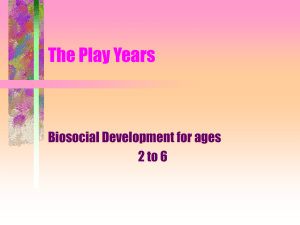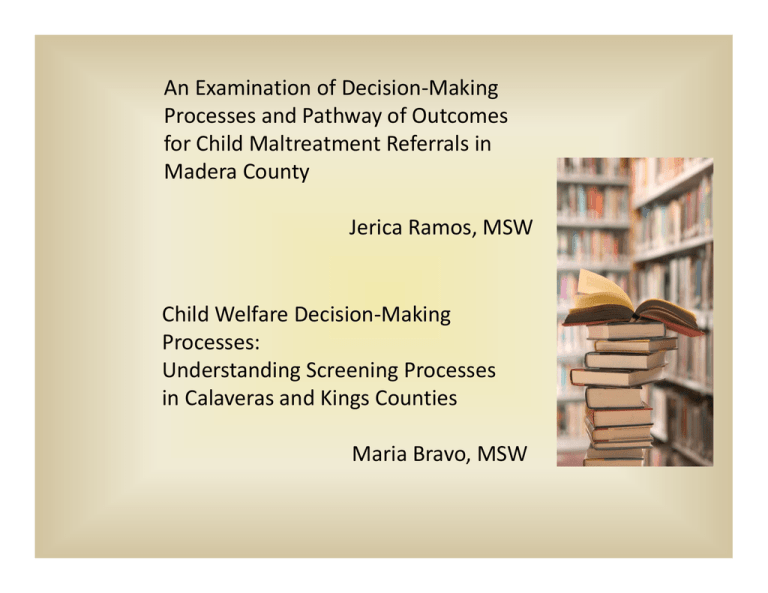
An Examination of Decision‐Making Processes and Pathway of Outcomes for Child Maltreatment Referrals in Madera County Jerica Ramos, MSW
Child Welfare Decision‐Making Processes: Understanding Screening Processes in Calaveras and Kings Counties
Maria Bravo, MSW
Purpose
Jerica
• To seek out trends in decision-making processes for Madera
County Child Welfare Services.
• To identify decision-making indicators that may be present.
Maria
• To examine decision-making processes that occur when a child
welfare agency receives a child maltreatment referral.
• To increase understanding of screening practices to better inform
child welfare practitioners, administrators, community members, and
policymakers about complex nature of child welfare decisionmaking.
Problem Statements
Jerica
• Little understanding of the factors that may be associated with the decisionmaking processes in child welfare.
• Explore decision-making pathways for child maltreatment referrals that are
evaluated out in Madera County.
Maria
• Decision-making related to child maltreatment referrals can be risky
business even with advancements, such as safety assessment tools and
training meant to improve the accuracy of detecting risk factors associated
with maltreatment.
• Errors in decision-making or screening are sometimes manifested in
evaluated out reports of child maltreatment.
• Screening errors can have unintended consequences such as public turmoil,
private distress, and a loss in public confidence in CPS.
Conceptual Frameworks
Jerica
• Decision complexity and organizational factors
• Decision-making barriers
• Decision-making models
Maria
• Structured Decision-Making (SDM)
– Incorporates research-based risk assessment tools to guide decision-making in
child welfare and to allow agencies to target cases that are most at risk (CDSS,
2007).
• Decision-Making Ecology (DME)
– Mutual connections between case, organizational, community, and individual
factors influencing case decisions and client outcomes (Wells et al., 2007).
• Organizational Operations Theory
–
Organizational culture is shaped by several factors: management style, social
function, autonomy level and expectations of workers (Rzepnicki & Johnson,
2005).
Research Questions
Jerica
• What are the characteristics of child maltreatment referral for Madera County?
• What are the decision‐making pathways for child maltreatment referral in Madera County?
Maria
• Does Calaveras County have higher incidences of evaluate‐out child maltreatment referrals in comparison to California? • Does Kings County have higher incidences of evaluate‐
out child maltreatment referrals in comparison to California? Methodology
• Secondary Data Analysis: Data from Center for Social Services Research (CSSR) and the National Council on Crime and Delinquency’s (NCCD) Children’s Research Center (CRC). • Subjects: Children in California between the ages of 0 to 17, who are involved with Calaveras, Kings & Madera CWS due to alleged child maltreatment.
• Data Analysis: Descriptive analysis and discussion of findings.
Child Population by Age Group
2012
50%
45%
N=8,280
N=40,866
N=42,037
N=9,170,525
40%
35%
30%
0‐5
25%
6‐10
11‐17
20%
15%
10%
5%
0%
Calaveras
Kings
Madera
California
CA Dept. of Finance
Child Maltreatment Allegations:
Incidences per 1000
120
100
80
Calaveras
60
Kings
Madera
California
40
20
0
2009
2010
2011
2012
Source: CSSR
Child Maltreatment
Allegation Type ‐ 2012
70%
N=664
N=2,818
60%
N=2,949
N=487,242
50%
Sexual Abuse
40%
Physical Abuse
General Neglect
30%
Emotional Abuse
At Risk Sibling
Other
20%
10%
0%
Calaveras
Kings
Madera
California
Source: CSSR
Calaveras County: Disposition Type
35%
N=866
N=699
N=664
30%
25%
20%
Substantiated
Inconclusive
Unfounded
15%
Assessment Only/Evaluated Out
10%
5%
0%
2010
2011
2012
Source: CSSR
Kings County: Dispositions Type
50%
45%
N=2,472
N=2,429
N=2,818
40%
35%
Substantiated
30%
Inconclusive
25%
Unfounded
Assessment Only/Evaluated Out
20%
Not Yet Determined
15%
10%
5%
0%
2010
2011
2012
Source: CSSR
Madera County:
Disposition Type
70%
N=2,799
60%
N=2,949
50%
N=2,823
Substantiated
40%
Inconclusive
Unfounded
30%
Assessment Only/Evaluated Out
Not Yet Determined
20%
10%
0%
2010
2011
2012
Source: CSSR
Evaluated Out: County/California Comparison
40.0%
35.0%
Calaveras
30.0%
Kings
25.0%
Madera
California
20.0%
15.0%
10.0%
5.0%
0.0%
2009
2010
2011
2012
Source: CSSR
Calaveras County:
Allegation Type/Evaluated Out
300
N=265
250
N=218
Other
200
N=164
At Risk, Sibling
Abused
Emotional Abuse
General Neglect
150
Physical Abuse
Sexual Abuse
100
50
0
2010
2011
2012
Source: CSSR
Kings County:
Allegation Type/Evaluated Out
3000
N=2,818
N=2,472
N=2,429
2500
Other
Severe Neglect
2000
Caretaker
Absence/Incapacity
At Risk, Sibling Abused
1500
Emotional Abuse
General Neglect
1000
Physical Abuse
500
Sexual Abuse
0
2010
2011
2012
Source: CSSR
Madera County
Allegation Type/Evaluated Out
3500
3000
N=2,823
N=2,799
N=2,949
Other
Severe Neglect
2500
Caretaker
Absence/Incapacity
2000
At Risk, Sibling Abused
Emotional Abuse
1500
General Neglect
1000
Physical Abuse
500
Sexual Abuse
0
2010
2011
2012
Source: CSSR
Calaveras County:
Evaluated Out by Age Group
100%
N=316
N=265
N=218
N=164
48%
54%
44%
44%
90%
80%
70%
60%
11‐17
50%
40%
6‐10
27%
23%
23%
32%
25%
23%
33%
24%
2011
2012
0‐5
30%
20%
10%
0%
2009
2010
Source: CSSR
Kings County:
Evaluated Out by Age Group
100%
N=707
N=612
N=570
42%
39%
41%
N=580
90%
80%
70%
41%
60%
11‐17
50%
28%
27%
25%
29%
6‐10
0‐5
40%
30%
20%
10%
30%
34%
34%
2009
2010
2011
31%
0%
2012
Source: CSSR
Madera County:
Evaluated Out by Age Group
100%
N=766
N=851
N=439
N=327
44%
40%
44%
90%
80%
70%
46%
60%
11‐17
50%
40%
6‐10
26%
26%
28%
27%
0‐5
30%
20%
10%
28%
30%
32%
29%
2009
2010
2011
2012
0%
Source: CSSR
Calaveras County: Recurrence of Allegation–Assessment Only
100%
90%
80%
70%
Substantiated
60%
Inconclusive
50%
Unfounded
Evaluated Out
40%
No Recurrence
30%
B=408
B=302
B=274
2009
2010
2011
20%
10%
0%
Source: CSSR
Kings County:
Recurrence of Allegation‐Assessment Only
100%
90%
80%
70%
Substantiated
60%
Inconclusive
50%
Unfounded
Evaluated Out
40%
No Recurrence
30%
B=978
B=853
B=834
2009
2010
2011
20%
10%
0%
Source: CSSR
Madera County:
Recurrence of Allegation‐Assessment Only
100%
90%
80%
70%
Substantiated
60%
Inconclusive
50%
Unfounded
Evaluated Out
40%
No Recurrence
30%
B=1051
B=1147
2009
2010
B=615
20%
10%
0%
2011
Source: CSSR
CRC/SDM Safety Assessment Results
Removal/Placement
18%
16%
N=338
14%
N=320
12%
N=1,022
N=409
10%
8%
6%
Calaveras
Kings
N=986
N=909
4%
N=994
N=1,325
N=1,219
2%
0%
2010
2011
2012
Madera
CRC/SDM 2012: Most Prevalent Safety Threats in Removal Households
70%
N=54
60%
N=105
N=128
50%
40%
Caregiver Substance Abuse
Child Immediate Need not Meet
30%
Failure to Protect
20%
10%
0%
Calaveras
Kings
Madera
Source: CRC/SDM
CRC/SDM 2012
Most Frequent Priority Family Need
70%
N=62
60%
N=142
N=88
50%
40%
Mental Health/Coping Skills
Substance Abuse/Use
30%
Parenting Skills
20%
10%
0%
Calaveras
Kings
Madera
Source: CRC/SDM
CRC/SDM 2012
Most Frequent Child Need
45%
N=94
40%
35%
30%
N=193
25%
Family Relationships
Emotional/Behavioral
Education
20%
Peer/Adult Social Relationships
N=280
Child Development
15%
10%
5%
0%
Calaveras
Kings
Madera
Source CRC/SDM
Implications of Findings for Social Work Practice
Jerica
• Increased knowledge of decision-making pathways in Madera CWS.
• Service provision and need
• Benefits to San Joaquin Valley and surrounding counties
• Influence Madera CWS’ System Improvement Plan (SIP)
Maria
• As outcomes of child maltreatment reports depend largely on
decisions of child welfare officials, it is important to consider factors
that drive, influence, and affect these decisions to improve child
welfare screening practices.
• It is important to understand how features of human experience can
influence family involvement with CPS to strengthen child
maltreatment prevention and intervention efforts.
Future Areas of Study
Jerica
• Further study of increased removal of children by Madera County CWS since 2011.
• The extent to which substance abuse plays a role in child welfare involvement with families.
• This basis of information can segue into a more descriptive review of decision making.
Maria
• Further exploration of the possible factors influencing child welfare decisions. • Further analysis state, and county policies and protocols used in the review of child maltreatment allegations. • Further qualitative analysis of child maltreatment referrals received directly by Calaveras and Kings Counties.

